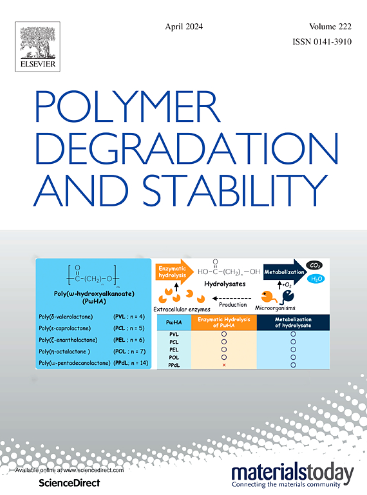Structural regulation of TLCP and evaluation of its long-term heat resistance after solid-state polymerization
IF 6.3
2区 化学
Q1 POLYMER SCIENCE
引用次数: 0
Abstract
In this paper, a series of liquid crystal polyarylates were synthesized through a two-step method involving p-hydroxybenzoic acid (HBA), 4,4′-biphenyldiol (BP), terephthalic acid (TA), and isophthalic acid (IA). By adjusting the IA content (0–5 mol%), it was found that the introduction of IA significantly reduced the melting point (Tm) and crystallinity of the polyarylate while retaining its liquid crystallinity. When the IA content was 3 mol%, the polyarylate exhibited both optimized processability (Tm = 282.7 °C) and thermal stability (T5 % > 360 °C). The polymerization process was further optimized, and solid-state polymerization (SSP) was employed to increase the molecular weight. The results demonstrated that under solid-state polymerization conditions of either 270 °C for 6 h or 280 °C for 3 h, the polyarylate achieved a tensile strength exceeding 100 MPa and a softening temperature above 300 °C. Using the stepwise isothermal method (SIM), the long-term performance of the polyarylate at elevated temperatures was predicted. The solid-state polymerized polyarylate showed a significant reduction in strain under a constant stress at 170 °C over 10 years, confirming its long-term thermal stability. This study provides a novel strategy for the structural design and performance optimization of high-temperature-resistant engineering plastics.

TLCP的结构调控及固态聚合后的长期耐热性评价
本文以对羟基苯甲酸(HBA)、4,4′-联苯二醇(BP)、对苯二甲酸(TA)、间苯二甲酸(IA)为原料,采用两步法合成了一系列液晶聚芳酯。通过调整IA的含量(0 ~ 5 mol%),发现IA的引入显著降低了聚芳酯的熔点(Tm)和结晶度,同时保持了聚芳酯的液态结晶度。当IA含量为3 mol%时,聚芳酯具有最佳的可加工性(Tm = 282.7℃)和热稳定性(T5 % >;360°C)。进一步优化聚合工艺,采用固态聚合(SSP)提高分子量。结果表明,在270℃固相聚合6 h或280℃固相聚合3 h下,聚芳酯的抗拉强度均超过100 MPa,软化温度在300℃以上。采用逐步等温法(SIM)预测了聚芳酯在高温下的长期性能。在170°C的恒定应力下,固态聚合聚芳酯在10年内的应变显著降低,证实了其长期的热稳定性。该研究为耐高温工程塑料的结构设计和性能优化提供了一种新的策略。
本文章由计算机程序翻译,如有差异,请以英文原文为准。
求助全文
约1分钟内获得全文
求助全文
来源期刊

Polymer Degradation and Stability
化学-高分子科学
CiteScore
10.10
自引率
10.20%
发文量
325
审稿时长
23 days
期刊介绍:
Polymer Degradation and Stability deals with the degradation reactions and their control which are a major preoccupation of practitioners of the many and diverse aspects of modern polymer technology.
Deteriorative reactions occur during processing, when polymers are subjected to heat, oxygen and mechanical stress, and during the useful life of the materials when oxygen and sunlight are the most important degradative agencies. In more specialised applications, degradation may be induced by high energy radiation, ozone, atmospheric pollutants, mechanical stress, biological action, hydrolysis and many other influences. The mechanisms of these reactions and stabilisation processes must be understood if the technology and application of polymers are to continue to advance. The reporting of investigations of this kind is therefore a major function of this journal.
However there are also new developments in polymer technology in which degradation processes find positive applications. For example, photodegradable plastics are now available, the recycling of polymeric products will become increasingly important, degradation and combustion studies are involved in the definition of the fire hazards which are associated with polymeric materials and the microelectronics industry is vitally dependent upon polymer degradation in the manufacture of its circuitry. Polymer properties may also be improved by processes like curing and grafting, the chemistry of which can be closely related to that which causes physical deterioration in other circumstances.
 求助内容:
求助内容: 应助结果提醒方式:
应助结果提醒方式:


